This month, Rand Bellavia takes a look at his growing longbox, and reflects on comics released in October in 1978, 1983, 1988, 1993, 1998, 2003, 2008, 2013!
Rand Bellavia is back to share his fond memories of decades of comic collecting and reading in this month’s Random Access Memory.
November 1978
Incredible Hulk 232
 This is the second part of a crossover story with Captain America 230. Looking at them now, I’m not entirely sure why I loved them so much. I suppose part of my love was the pure joy associated with getting both parts of a crossover. (Remember, this was back when you either got it off the rack at the pharmacy the month it was out or you were out of luck.) Also, Captain America 230 had a pretty cool cover:
This is the second part of a crossover story with Captain America 230. Looking at them now, I’m not entirely sure why I loved them so much. I suppose part of my love was the pure joy associated with getting both parts of a crossover. (Remember, this was back when you either got it off the rack at the pharmacy the month it was out or you were out of luck.) Also, Captain America 230 had a pretty cool cover:
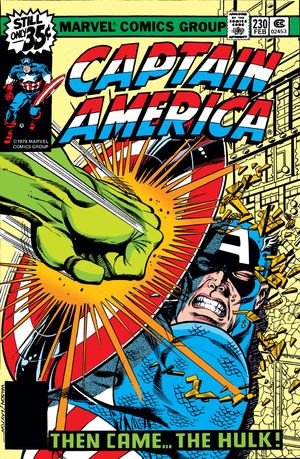
This issue picks up right where Captain America 230 left off, with the good guys unconscious and the bad guys gloating.
 It must have been strange for a regular Hulk reader to stumble across what is the final chapter of a long-brewing Captain America epic featuring a whole string of lesser known Marvel characters. (Starting with “DIE-E-E-E!” and moving clockwise, we have Animus, Quasar, Moondragon, and the Falcon.)
It must have been strange for a regular Hulk reader to stumble across what is the final chapter of a long-brewing Captain America epic featuring a whole string of lesser known Marvel characters. (Starting with “DIE-E-E-E!” and moving clockwise, we have Animus, Quasar, Moondragon, and the Falcon.)
As one might expect, the good guys get better, and defeat the super-villains. Eventually, Kligger finds himself in some serious trouble.
 By the way, those tempted to argue that Marvel’s new stuff is too political (i.e., too left wing) might want to note that in this story from 1978 (two years before Reagan was elected President) the bad guy is a multi-millionaire Congressman who secretly works for an evil empire that calls itself The Corporation.
By the way, those tempted to argue that Marvel’s new stuff is too political (i.e., too left wing) might want to note that in this story from 1978 (two years before Reagan was elected President) the bad guy is a multi-millionaire Congressman who secretly works for an evil empire that calls itself The Corporation.
Also note that even while slumming it in an issue of the Hulk, Cap can’t stop himself from brooding about America.
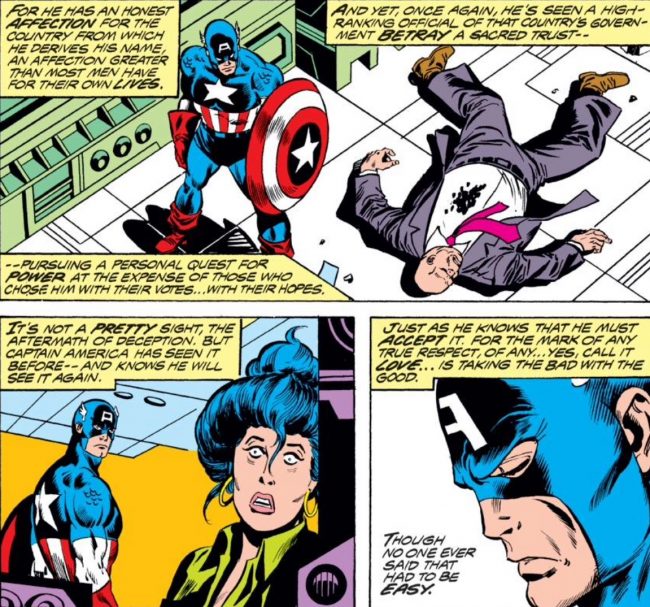 This issue also reveals that Jim Wilson (the Hulk’s late seventies sidekick) and Sam Wilson (the Falcon, Cap’s late seventies sidekick) are related. Turns out that Jim is the Falcon’s nephew — cleverly turning Captain America’s partner into Uncle Sam — and he is totally knocked out by this information.
This issue also reveals that Jim Wilson (the Hulk’s late seventies sidekick) and Sam Wilson (the Falcon, Cap’s late seventies sidekick) are related. Turns out that Jim is the Falcon’s nephew — cleverly turning Captain America’s partner into Uncle Sam — and he is totally knocked out by this information.
 It’s important to me that you understand that it is not that Jim was shocked to find out that his Uncle was the Falcon. He already knew that Sam Wilson was the Falcon. He just didn’t know that Sam Wilson was his uncle. That’s weird, right?
It’s important to me that you understand that it is not that Jim was shocked to find out that his Uncle was the Falcon. He already knew that Sam Wilson was the Falcon. He just didn’t know that Sam Wilson was his uncle. That’s weird, right?
Comics I Read From November 1978
- Amazing Spider-Man 189
- Avengers 180
- Captain America 230
- Marvel Team-Up 78
- Marvel Triple Action 46
- Ripley’s Believe It or Not 85
- Peter Parker the Spectacular Spider-Man 27
- Uncanny X-Men 118
November 1983
Saga of the Swamp Thing 21
 This is technically the second issue of Swamp Thing written by Alan Moore, but as issue 20 consisted primarily of Moore tying up plot threads from previous writer Marty Pasko (the issue was even titled “Loose Ends”) this is rightly considered the true beginning of Moore’s epic run on Swamp Thing.
This is technically the second issue of Swamp Thing written by Alan Moore, but as issue 20 consisted primarily of Moore tying up plot threads from previous writer Marty Pasko (the issue was even titled “Loose Ends”) this is rightly considered the true beginning of Moore’s epic run on Swamp Thing.
And he wastes no time in getting right to it. These days, Moore only seems to poke his head out of Northampton to complain about mainstream comics — famously accusing everyone who has written for DC since 1987 of just riffing on his ideas. Now I certainly agree that for the last 30 years comics (and DC, in particular) have been littered with writers not nearly as talented as Alan Moore who have sought to mimic his “grim and gritty” tone without any of the style or grace of his scripts. But it is wildly unfair of Moore to treat the reinterpretation of established ideas as a bug of DC, when it is in fact a feature, and has been since long before Moore came around. In fact, as someone who were there in the early 80s I can assure you that it was Moore’s ability to do exactly this that made him my favorite comic book writer.
Seeing his name on a comic meant that the characters were about to be reinvented in a unique, exciting, and “adult” manner, and — rather importantly — he did it while respecting established continuity (i.e., without just retconning his new idea in with a crowbar). Perhaps the best example of this was his work with Miracleman (nee Marvelman), but this issue of Swamp Thing is certainly his most famous example.
Swamp Thing has been captured by General Sunderland, the Big Bad of the previous issues. Sunderland hires Dr. Woodrue (The Floronic Man) to examine the unconscious Swamp Thing to see what makes him tick. Before this issue, Swamp Thing was your basic swamp monster, whose origin story involved scientist Alec Holland getting caught in an explosion that bathed him in his own bio-restorative formula. Alec fell into the water and emerged as the Swamp Thing, as one does. But, having studied the Swamp Thing, Woodrue has another idea, which he tries to explain to Sunderland using planarian worms as a metaphor.
 Sunderland doesn’t get it, so Woodrue retells Swamp Thing’s origin story, adding one little twist:
Sunderland doesn’t get it, so Woodrue retells Swamp Thing’s origin story, adding one little twist:
 Welcome to “realistic” comics. See, it’s totally unrealistic to think that Alec could enter the water, screaming and on fire, and live to tell the tale. Of course he died. The bio-restorative formula didn’t save Alec, but it did “work”:
Welcome to “realistic” comics. See, it’s totally unrealistic to think that Alec could enter the water, screaming and on fire, and live to tell the tale. Of course he died. The bio-restorative formula didn’t save Alec, but it did “work”:

Now, of course this isn’t realistic in the “this is something that happens” sense, but it is more realistic in the “that sounds just a tiny bit more plausible, or at least more well thought out” sense. This is also why people talking about comics often conflate the words “realistic” and “adult.” (This new origin story is “adult” in that only an adult would need these trappings of “realism” to enjoy the story.) And this conflation meant that it only took about five years for “realistic” and “adult” to change from meaning “plausible, or at least more well thought out” to meaning “senselessly violent and hyper-sexualized,” because we’re all worthy of destruction.
While we’re here, I should also point out that Woodrue only has half the picture, and it will take the introduction of John Constantine more than 15 issues from now to point out to Swamp Thing (and us) the supernatural aspects of Swamp Thing’s origin story. This also involves Moore brilliantly folding Len Wein and Bernie Wrightson’s original Swamp Thing short story (which told essentially the same tale in a different time and place and with different characters) into Saga of the Swamp Thing.
At any rate, Sunderland is not impressed with Woodrue’s theory, and throws him out. And the next time Sunderland sees Swamp Thing, Alec is not amused:
 And if Sunderland hasn’t been so hasty to get rid of Woodrue, he could have explained what might have Alec so worked up:
And if Sunderland hasn’t been so hasty to get rid of Woodrue, he could have explained what might have Alec so worked up:
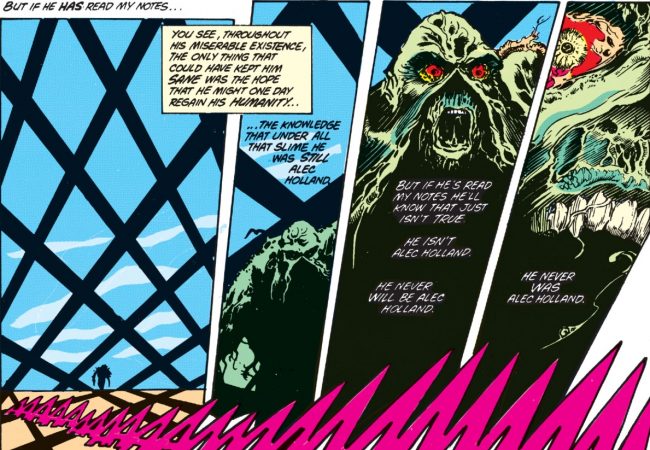 And that is how you reinterpret an established character without altering existing continuity. Also how you turn Saga of the Swamp Thing into a genuine horror comic. (Pro tip: It helps a lot to have your script illustrated by Steve Bissette and John Totleben.)
And that is how you reinterpret an established character without altering existing continuity. Also how you turn Saga of the Swamp Thing into a genuine horror comic. (Pro tip: It helps a lot to have your script illustrated by Steve Bissette and John Totleben.)
Comics I Read From November 1983
- Alpha Flight 7
- Amazing Spider-Man 249, 250
- Avengers 240
- Badger 2
- Captain America 290, 291
- Cerebus 56
- Conan the King 21
- Defenders 128
- Elektra Saga 1
- Green Lantern/Green Arrow 5
- Jack of Hearts 2
- New Teen Titans 39
- Peter Parker the Spectacular Spider-Man 87
- Silverheels 1
- Somerset Holmes 2
- Thor 340, 341
- Thriller 4
- Uncanny X-Men 178
- Vigilante 3
- What If 43
November 1988
Animal Man 7

In between the initial four-issue storyline of Grant Morrison’s Animal Man and the proper start of the overall story that begins with issue 10 and ends in issue 26, there are five pretty great done-in-one issues. This one begins with Buddy fighting a bunch of malfunctioning killer robots and then landing on a rooftop to find a man about to jump from the building.
 Demonstrating his inability to understand visual context clues, Buddy assumes The Red Mask is a super-hero.
Demonstrating his inability to understand visual context clues, Buddy assumes The Red Mask is a super-hero.
 Morrisey fans should note that Morrison’s Animal Man and Doom Patrol are littered with lyrical references to Smiths songs — in this case “If you’ve got five second to spare / I’ll tell you the story of my life” is taken from Half a Person.
Morrisey fans should note that Morrison’s Animal Man and Doom Patrol are littered with lyrical references to Smiths songs — in this case “If you’ve got five second to spare / I’ll tell you the story of my life” is taken from Half a Person.
Red Mask fills Animal Man in on his origin story, explaining how his power set kind of dictated his morality.
 Note how — from the very beginning of his career at DC — Morrison understands that “adult” doesn’t necessarily mean dark, and that “realistic” doesn’t necessarily mean believable. Here he gleefully embraces the notion that in the DC Universe meteors are constantly crashing to earth, and spaceships are just as frequently blowing up in people’s faces, with both events doling out utterly random super-powers like cookies at a blood drive. A few issues later, Morrison gives Animal Man’s origin story a Swamp Thing-esque reinterpretation, but only after he makes it clear that he’s fine with it as it was.
Note how — from the very beginning of his career at DC — Morrison understands that “adult” doesn’t necessarily mean dark, and that “realistic” doesn’t necessarily mean believable. Here he gleefully embraces the notion that in the DC Universe meteors are constantly crashing to earth, and spaceships are just as frequently blowing up in people’s faces, with both events doling out utterly random super-powers like cookies at a blood drive. A few issues later, Morrison gives Animal Man’s origin story a Swamp Thing-esque reinterpretation, but only after he makes it clear that he’s fine with it as it was.
But even after hearing the Red Mask’s origin story, Buddy still doesn’t get it. I mean, he doesn’t seem like such a bad guy, so how could he be a Bad Guy?
 Black Orchid 1
Black Orchid 1
 Neil Gaiman has often told the story of how he mentioned reviving Black Orchid at his first DC pitch meeting, and editor Karen Berger asked him who “Blackhawk Kid” was. Which is another way of saying that Black Orchid made Animal Man look positively famous. Having no idea who Neil Gaiman or Black Orchid were, I picked this comic up because Dave McKean had gotten my attention with Arkham Asylum and his Hellblazer covers.
Neil Gaiman has often told the story of how he mentioned reviving Black Orchid at his first DC pitch meeting, and editor Karen Berger asked him who “Blackhawk Kid” was. Which is another way of saying that Black Orchid made Animal Man look positively famous. Having no idea who Neil Gaiman or Black Orchid were, I picked this comic up because Dave McKean had gotten my attention with Arkham Asylum and his Hellblazer covers.
The comic opens with a business meeting. Just as we’re figuring out that this is a super-villain business meeting, we learn that Black Orchid is there undercover. But not nearly as undercover as she thought.
 Then, Gaiman does something fairly unexpected.
Then, Gaiman does something fairly unexpected.

The comic is well-written (as, with hindsight, one would expect), but — like most British writers working for DC in the late eighties — Gaiman is trying a little too hard to write like Alan Moore. This leads to pages like this, which are clever, but not really in Gaiman’s voice.

Honestly, Gaiman didn’t make nearly as strong an impression on me here as McKean’s design, painting, and storytelling did:

Sandman 1
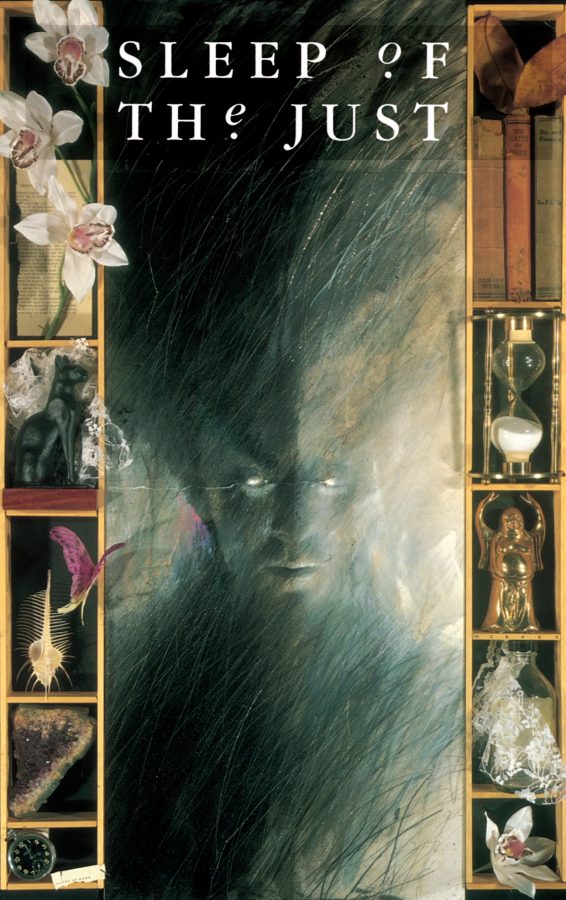
Black Orchid was one of two new DC comics written by Neil Gaiman that came out this month. You may have heard of this one. The earliest Sandman issues were illustrated by Sam Kieth, which makes for an impressive if unlikely pairing. Kieth didn’t last very long, and wasn’t really a great fit for the title, but those sweet sweet “created by” checks keep rolling in nonetheless.
This issue introduces the character of Morpheus without telling us very much about him. Early in the 20th century, an Aleister Crowley type tries to conjure Death and gets Dream by mistake.
 We don’t learn about the Endless until much later, but it’s clear that Gaiman has this all mapped out from beginning. And while it’s not clear that our Magus understands that he has captured Dream, his absence from the Dreaming is noticed.
We don’t learn about the Endless until much later, but it’s clear that Gaiman has this all mapped out from beginning. And while it’s not clear that our Magus understands that he has captured Dream, his absence from the Dreaming is noticed.

It is a clever conceit that the absence of Dream for much of the 20th century led to two world wars, the Holocaust, the ability to wipe out all life on earth with the push of a button, and other horrors that were unimaginable a century ago.
So, Morpheus spends a lifetime (from our perspective) in captivity. The man responsible for his imprisonment dies of old age. After nearly a century, Morpheus frees himself and confronts the son of the man responsible for his imprisonment.

This is exactly what you think it is.

Luckily, our man wakes up from that nightmare. Wait… Did I say luckily?

Other Comics I Read from November 1988
- Cerebus 116
- Concrete 10
- Dr. Fate 2
- Dreadstar 41
- Havok & Wolverine: Meltdown 1
- Hellblazer 15
- Incredible Hulk 353
- Mister Miracle 1
- Neat Stuff 12
- Next Nexus 3
- Punisher 17
- Question 23
- Secret Origins 36
- Stray Toasters 3
- Swamp Thing 82
- V for Vendetta 7
- Wasteland 15
- West Coast Avengers 22
- Whisper 22
- Yummy Fur 13
November 1993
Golden Age 4

Before his career-defining run on Starman, James Robinson gave us the Golden Age, an alternate history of the DC’s WWII era heroes. Like most “adult” super-hero narratives of the time, Golden Age imagines super-heroes living in the real world — a world of moral and political complexity, where the bad guys sometimes win. And, just like in our world, often the easiest way for the bad guys to win is to pretend to be the good guys. Things look pretty bleak until Miss America makes her stand.

Her speech inspires the heroes around her, but also enrages the villains hiding among them, including Robotman.

Robotman is easily dispatched, and Miss America’s death exposes Thompson for who he is.

They Stole Hitler’s Brain! That’s right, James Robinson’s third act plot twist was a National Enquirer headline.
Most of this issue is devoted to Hitler/Thompson mercilessly mowing his way through all of your favorite Golden Age DC heroes. But Starman is conspicuously absent. Of course, anyone reading this with hindsight could probably predict that Starman would make a dramatic last minute appearance. But what happens after that is much less predictable.

With all of the main heroes dead or defeated, Hitler claims victory. Then an unknown, and not particularly powerful — hero finds the courage to attack him.

And while Starman was defeated, his cosmic rod (I know) still has something to say.
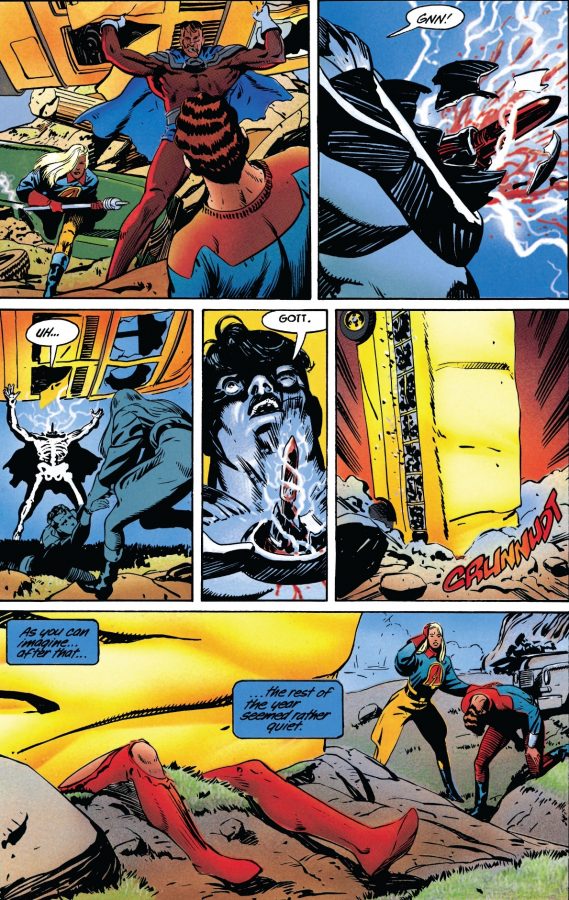
Cool that it was two super-heroic women who saved the day. (Also can’t help but note that this comic came out 25 years ago, and no one seemed to have a problem with it back then.)
Marvels 1

I don’t have a sense of how revered (or even read) this comic is 25 years later, but I can promise you that when it came out, this book was both popular and important. Painted comics were certainly a thing well beforehand, but Marvels made painted comics a lucrative thing. It also made Alex Ross a star. (And it wasn’t bad for Kurt Busiek’s career, either.)
The art may have been the main attraction, but it was Busiek’s “Man on the Street” perspective on super-heroes that made the story work. Essentially, this is a retelling of the early years of the Marvel Universe, through the eyes of a photojournalist.

Following the publishing history of Marvel, we start with the android Human Torch, and work our way to Namor.

Busiek and Ross are both perfect at telling us a story we already know but making us feel like we’re hearing (and perhaps more importantly seeing) it for the first time.
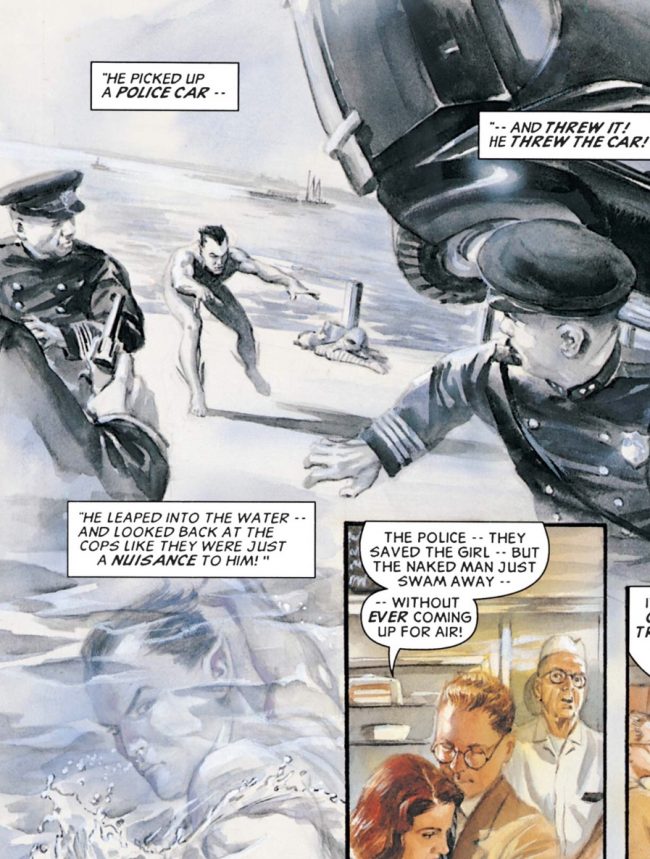
Comics I Read from November 1993
- 1963 6
- Aliens: Salvation
- Animal Man 67, Annual 1
- Aquaman: Time and Tide 1
- Arcana Annual 1
- Cerebus 176
- Children’s Crusade 2
- Daredevil: The Man Without Fear 4
- Death Gallery
- Demon 43
- Eightball 12
- Extremist 4
- Flash 86
- Hellblazer 73
- Incredible Hulk 413
- Justice League Task Force 8
- Maxx 6
- Sandman Mystery Theater 10
- Scarab 2
- Shade the Changing Man 43
- Swamp Thing Annual 7
- Vroom Socko
November 1998
Invisibles 21

Nothing too unusual or abnormal about this issue of the Invisibles. But this is the Invisibles we’re talking about, so here are four “usual” panels from this “normal” issue of the Invisibles, curated for your pleasure.
We’ve got meta-fiction: Time Travel:
Time Travel:

Buddhism:

And whatever the hell this is: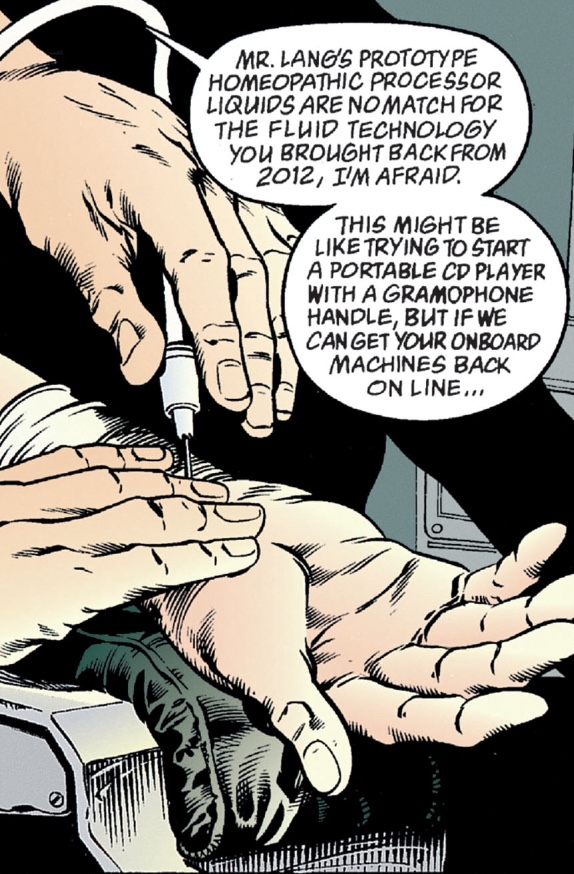
(It’s the secret of how to travel through time you Plebeian. )
Preacher 45

This issue features more of Jessie getting to know Gunther:
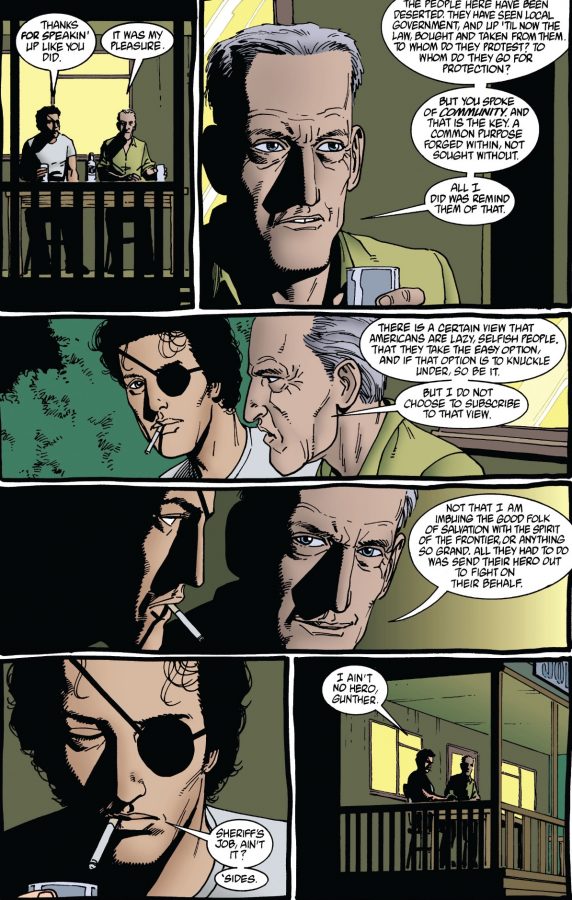
As well as Jesse’s rather unique response to a burning cross on his deputy’s lawn:

Other Comics I Read from November 1998
- Avengers 12
- Avengers Forever 2
- Batman Chronicles 15
- Batman/Hellboy/Starman 1
- Captain America 13
- Captain America: Sentinel of Liberty 5
- Daredevil 3
- DCU Holiday Bash 3
- Flash 144
- Grendel: Red, White, and Black 1
- Guns of the Dragon 4
- Hellblazer 133
- Hitman 33
- Inhumans 3
- Iron Man/Captain America ’98 1
- JLA 25
- JLA/Titans 2
- Legends of the DC Universe 12
- Minx 4
- Starman 49, 80-page Giant 1
- Superman Adventures 27
- Superman: Peace on Earth
- Transmetropolitan 17
- Vetigo: Winter’s Edge 2
- Webspinners: Tales of Spider-Man 1
- You are Here
November 2003
New X-Men 149

Most multi-part super-hero stories start with the villain’s (all too often lack of) motivation, move on to their plan, build to their seeming defeat of our heroes, and then end with our heroes overcoming the odds to defeat the villain in battle. This story begins with a major reveal — that Magneto had been hiding in plain sight as the seemingly heroic Xorn (a feat that must have taken an insane amount of preparation, planning, and forethought) — and then spends the next four issues charting Magneto’s almost immediate fall into addiction, foolishness, and the hubris that often accompanies evil.
But before you accuse Grant Morrison of having no respect for the work Chris Claremont did to redeem Magneto, check out this amazing moment:
 Apparently, not only is Magneto better than even he thought, but Xorn is more real than he thought, as well.
Apparently, not only is Magneto better than even he thought, but Xorn is more real than he thought, as well.

But he still doesn’t quite get it. He should have stayed Xorn.

Fittingly, it is Xorn’s star pupil (and the formerly villainous Cassandra Nova) who delivers the intellectual killing blow.

Other Comics I Read from November 2003
- Alias 28
- Astro City: Local Heroes 5
- Autobiographix
- Avengers 74
- Batman 621
- Batman: Death and the Maidens 4
- Captain America 20
- Catwoman 25
- Cloudfall 1
- Conan 0
- Empire 5
- Fantastic Four 506, 507
- Flash 204
- Gotham Central 13
- Hawkman 21
- Hellblazer 190
- Human Target 4
- Incredible Hulk 63
- Invincible 9
- JLA/Avengers 3
- JSA 54
- JSA All Stars 7
- Losers 6
- Lucifer 44
- Mother, Come Home
- Possessed 5
- Powers 35
- Punisher 35, 36
- Runaways 8
- Sleeper 11
- Smax 4
- Spider-Man/Doctor Octopus: Negative Exposure 2
- Superman: Birthright 5
- Teen Titans 5
- Thor: Vikings 5
- Trouble 5
- Ultimate Six 4
- Ultimate Spider-Man 49
- Ultimate X-Men 39
- Walking Dead 2
- Wolverine 7, 8
- Wonder Woman 198
- X-Statix 16
- Y: The Last Man 16
November 2008
Batman 683

Toward the beginning of Final Crisis, Batman was captured by Darkseid’s minions, but we never learned why until this issue of Batman came out.

Assuming that it was the tragedy in Bruce’s life that created Batman, Darkseid’s plan was to use that trauma to create an army of Batman clones. But it turns out that it wasn’t the trauma that created Batman, but rather Bruce Wayne’s unique ability to handle that level of tragedy without cracking.

But before anyone can figure out what’s happening, things fall apart, and they have to abandon the laboratory.

It’s a bit sweaty that they left Batman’s utility belt for him to grab, but I love the idea of Batman weaponizing his own memories.
We also get this amazing thought from Alfred:

Batman prepares for everything, and Alfred has more faith in Batman than even Bruce does.


Final Crisis 6
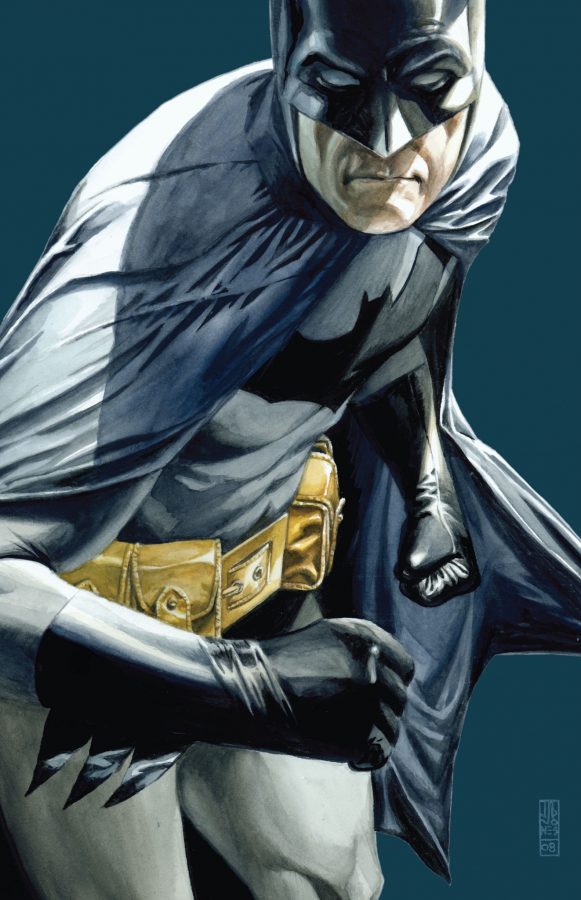
But what happened to Batman? He woke up in the abandoned laboratory, and got to work.

This is, of course, huge. Batman using a gun. Many critics have claimed that this was out of character. I disagree. Bruce makes it clear that the occasion rises above his own belief system. This is like German theologian Dietrich Bonhoeffer plotting the assassination of Hitler — he never stopped believing that murder was sinful, he simply acknowledged that Hitler’s evil was great enough that his soul would have to bear the burden of that sin.

Readers of Jack Kirby’s Fourth World books know that the Omega Sanction/Effect was only used by Darkseid once before, on Sonny Sumo. While he disappeared (and was thought dead by the Forever People) the reader sees that he was in fact shunted back in time. Which is to say, the idea of Batman being thought dead by those around him but actually being sent back in time is not a violation of pre-existing continuity.
But then what about this?
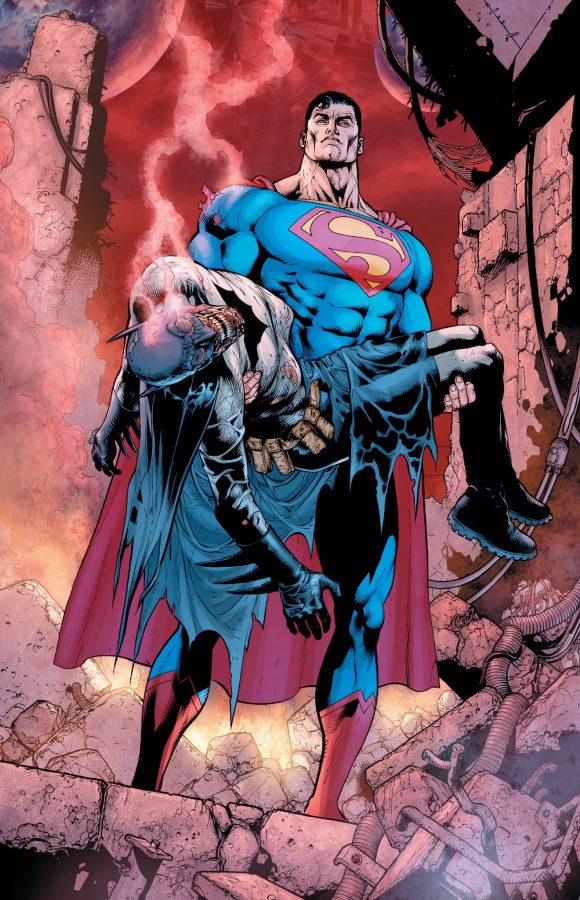
If you must know, that is the burned body of one of the clones mentioned in Batman 683. This becomes a major plot point in the Batman and Robin series, when Dick Grayson takes this corpse to a Lazarus Pit and unknowingly resurrects a clone that had been driven insane by Bruce’s memories.
Other Comics I Read from November 2008
- 100 Bullets 97
- Action Comics 871
- Air 4
- Amazing Spider-Man 578
- Avengers: The Initiative 19, Special 1
- Back to Brooklyn 2
- Batman 682
- Captain America 44
- Daredevil 113
- DMZ 36
- Ex Machina 39
- Fantastic Four 561
- Final Crisis: Revelations 4
- Gemini 3
- Goon 30
- Green Lantern 36
- Green Lantern Corps 30
- Hellblazer Special: Chas 5
- I Kill Giants 5
- Incredible Hercules 123
- Invincible 55
- Invincible Iron Man 7
- Iron Man: Director of SHIELD 35
- JSA 21
- JSA Kingdom Come Special: Magog
- JSA Kingdom Come Special: Superman
- JSA Kingdom Come Special: The Kingdom
- Marvel Zombies 3 2
- New Avengers 47
- Nightwing 150
- Northlanders 12
- Pax Romana 4
- Punisher War Journal 25
- Scalped 23
- She-Hulk 35
- Skaar: Son of Hulk 5
- Sub-Mariner: The Depths 3
- Thor 12
- Thor: Man of War
- Thunderbolts 126
- Tiny Titans 10
- Transhuman 4
- Ultimate Spider-Man 128
- Ultimatum 1
- Uncanny X-Men 504
- Unknown Soldier 2
- Vixen: Return of the Lion 2
- Walking Dead 54
- Wolverine 69
- Wolverine: Manifest Destiny 2
- X-Factor 37
- X-Men/Spider-Man 1
- X-Men: Magneto: Testament 3
November 2013
Captain Marvel 17

Kelly Sue DeConnick’s Captain Marvel is a joy to read from beginning to end, but this is my favorite issue of the original run. It’s not heavy on plot, and features Carol interacting with children a lot. Here we see her speaking with a very shy boy who made his own Iron Man mask.
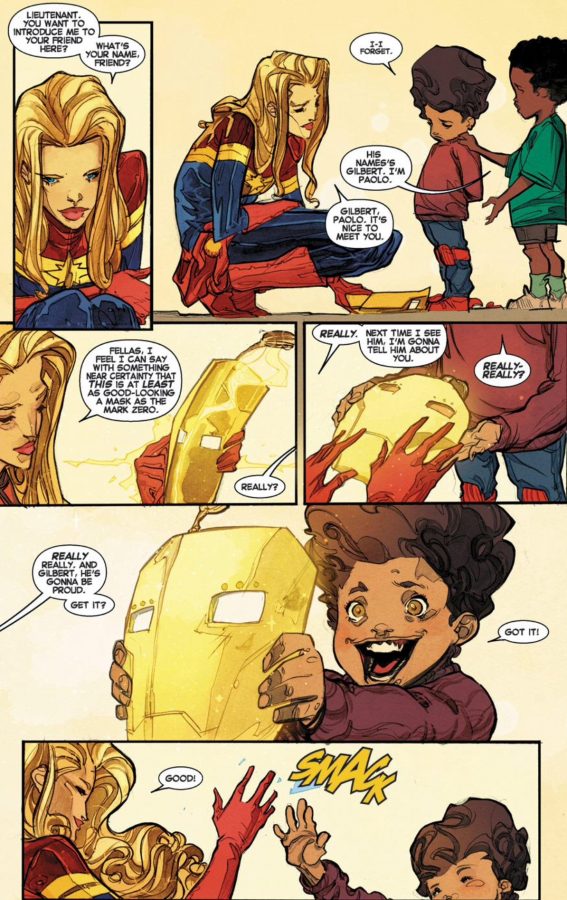
Carol spends a lot of time with Kit, the daughter of a friend of hers who is eager to learn about being Captain Marvel. Unfortunately, Carol is having memory problems due to a head injury.

Carol shows Kit her secret hideout.

For several previous issues, the idea of Carol teaching Kit what it means to be Captain Marvel has been a point of discussion. And this turn is just fantastic.

Sex Criminals 3

I have always felt at my most creative when I have specific limitations. Knowing the field helps to narrow your focus. The first time we worked with a producer on a recording project, he shared this quote with me:
“My freedom will be so much the greater and more meaningful the more narrowly I limit my field of action and the more I surround myself with obstacles. Whatever diminishes constraint diminishes strength. The more constraints one imposes, the more one frees one’s self of the chains that shackle the spirit.” — Igor Stravinsky, 1947
When Monty Python were making the Holy Grail and they found out at the last second that they wouldn’t be able to use horses, one of them just said, “Get me some coconuts.” And when the funding for the big train scene that was the be the climax of Brian DePalma’s The Untouchables fell through, he said, “Get me a clock, a stairway, and a baby carriage” and made a much more dramatic and memorable scene for almost no money.
The script for this issue of Sex Criminals had a scene with the main characters hanging out in a bar while Queen’s Fat Bottomed Girls played in the background. I don’t know why that was important to Matt Fraction, but it was. But they couldn’t work out the rights with Queen’s people in time. And the issue became a thousand times more interesting.
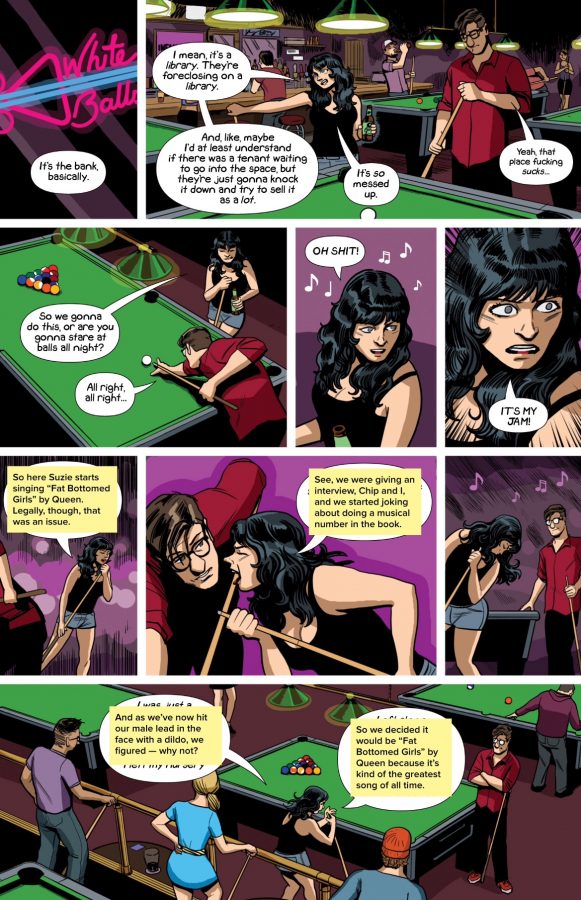

Also, we finally get to the “criminals” part of Sex Criminals:

Other Comics I Read from November 2013
- 100 Bullets: Brother Lono 6
- Action Comics 25
- Activity 15
- Afterlife with Archie 2
- All-New X-Men 18, 19
- Amazing X-Men 1
- Animal Man 25
- Aquaman 25
- Archer and Armstrong 15
- Astro City 6
- Avengers 23
- Avengers Assemble 21
- Batman 25
- Batman and Robin 25
- Batman/Superman 5
- Black Science 1
- Bloodshot and HARD Corps 16
- Brain Boy 3
- Buzzkill 3
- Captain America: Living Legend 3
- Daredevil 33
- East of West 7
- Eternal Warrior 3
- Fatale 18
- Fifth Beatle: The Brian Epstein Story
- Forever Evil 3
- Goon 44
- Green Arrow 25
- Hawkeye 14
- Indestructible Hulk 15, 16
- Infinity 6
- Infinity: The Hunt 4
- Iron Man 18
- Itty Bitty Hellboy 4
- Justice League 25
- Kick-Ass 3 5
- Manhattan Projects 16
- New Avengers 12
- Powers Bureau 8
- Pretty Deadly 2
- Protectors Inc. 1
- Rat Queens 3
- Revival 1
- Rocketeer/the Spirit: Pulp Friction 3
- Saga 16
- Secret Avengers 11
- Shadowman 12
- Sheltered 5
- Sidekick 4
- Superman/Wonder Woman 2
- Superior Foes of Spider-Man 5
- Superior Spider-Man 21, 22, Annual 1
- Thief of Thieves 18
- Thor: God of Thunder 15
- Three 2
- Trillium 4
- Unity 1
- Walking Dead 116, 117, Tyreese Special
- Witching Hour 1
- Wolverine and the X-Men 38
- Wonder Woman 25
- Young Avengers 12
- Zero 3
Dear Spoilerite,
At Major Spoilers, we strive to create original content that you find interesting and entertaining. Producing, writing, recording, editing, and researching requires significant resources. We pay writers, podcast hosts, and other staff members who work tirelessly to provide you with insights into the comic book, gaming, and pop culture industries. Help us keep MajorSpoilers.com strong. Become a Patron (and our superhero) today.

